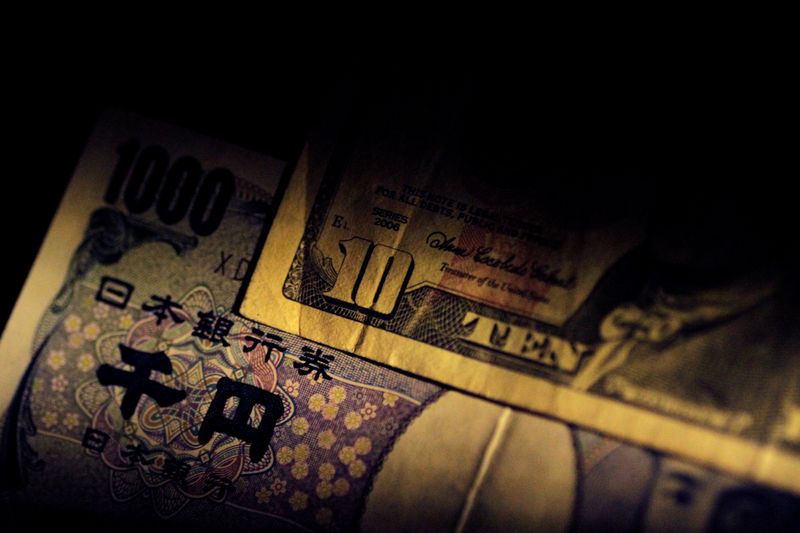Forex
Dollar reined in by threat of Japanese intervention, yen fragile

By Amanda Cooper
LONDON (Reuters) -The dollar backed off the key 160 yen level on Tuesday, as fears of intervention from Japanese officials deterred traders from punishing the yen too severely against any other currencies.
Elsewhere, bitcoin recovered some lost ground after its worst day in more than two months at the start of the week, in part due to flows out of bitcoin exchange-traded funds (ETFs), analysts said.
The dollar was last 0.1% lower at 159.43 yen, clinging to a tight range, as traders remained wary of testing a level that prompted a 9.79 trillion yen ($61.33 billion) currency intervention from Tokyo in late April and early May.
That kept the yen hemmed in and stopped it hitting fresh lows against other currencies, with sterling sitting just below a 16-year high at 202.34 yen.
“The market is showing … that they are nervous, and they are very much on edge about this situation,” said Chris Weston, head of research at Pepperstone.
“There are inherent risks to being short the Japanese yen now as a carry trade, which is of course what (authorities) want to see.
“The first port of call is to tell currency speculators and people holding for carry that you’re on notice, if you hold those positions now, you run the risk of a 400-, 500-pip drop in dollar/yen.”
The latest decline in the yen has come on the back of the Bank of Japan’s (BOJ) June policy meeting, where policymakers disappointed investors who were betting on an immediate reduction of the BOJ’s massive bond purchases.
Minutes of the meeting out on Monday showed the central bank debated the chance of a near-term interest rate hike with one policymaker calling for an increase “without too much delay”.
In the broader market, the dollar eased slightly ahead of Friday’s release of the U.S. personal consumption expenditures (PCE) price index – the Federal Reserve’s preferred measure of inflation.
Sterling was up 0.1% at $1.2691, while the Australian dollar was flat at $0.6656.
was also under pressure, weakening to 7.2626 to the dollar, within sight of the lower end of the central bank’s daily trading limit, at 7.265 on Tuesday.
The yuan has never breached this threshold.
POLITICS IN FOCUS
Politics were also at the forefront of investors’ minds, with the first U.S. presidential debate between President Joe Biden and his predecessor Donald Trump set for Thursday and French elections due to begin this weekend.
The euro, which has come under pressure amid political turmoil in France in the wake of President Emmanuel Macron’s shock snap election call earlier this month, dipped 0.1% to $1.0721, set for a monthly loss of 1%.
However, it is still trading in the $1.07-1.08 range it has held for most of this year.
“It increasingly seems to me that it will take a big surprise to move the rate out of this range in a sustainable way,” Commerzbank (ETR:) strategist Volkmar Baur said.
On the markets front, Baur cited Friday’s U.S. core inflation figures as one potential catalyst and German and French inflation data next week as another.
On the political front, Baur noted Sunday’s election in France is only a first round of voting, and the results “would have to differ significantly from the polls” to have a big impact.
The dollar was firm at 105.51 against a basket of currencies.
In cryptocurrencies, bitcoin rose 3.1% to $61,348, recovering some of the previous day’s 6.65% fall that was driven by ongoing investment outflows.
“We’ve seen drawdown, we’ve seen six days in a row of funds coming out of the bitcoin cash ETFs,” said Pepperstone’s Weston.

“, for me, is … a momentum vehicle, and momentum works both ways. If it’s going in one direction and the rate of change is picking up, for me, you stand aside and let the selling happen until it can form a base. And right now, the momentum’s to the downside.”
($1 = 159.6300 yen)

 Forex3 years ago
Forex3 years agoForex Today: the dollar is gaining strength amid gloomy sentiment at the start of the Fed’s week

 Forex3 years ago
Forex3 years agoUnbiased review of Pocket Option broker

 Forex3 years ago
Forex3 years agoDollar to pound sterling exchange rate today: Pound plummeted to its lowest since 1985

 Forex3 years ago
Forex3 years agoHow is the Australian dollar doing today?

 Cryptocurrency3 years ago
Cryptocurrency3 years agoWhat happened in the crypto market – current events today

 World3 years ago
World3 years agoWhy are modern video games an art form?

 Commodities3 years ago
Commodities3 years agoCopper continues to fall in price on expectations of lower demand in China

 Economy3 years ago
Economy3 years agoCrude oil tankers double in price due to EU anti-Russian sanctions





















